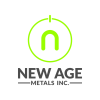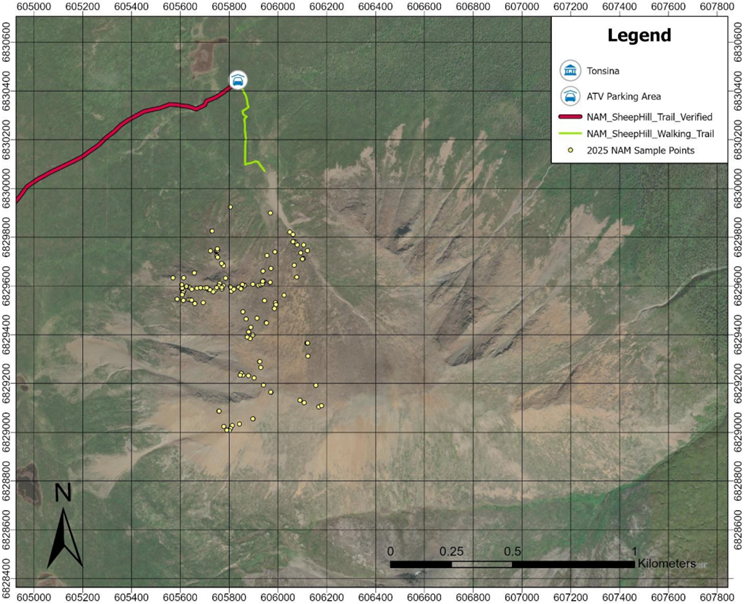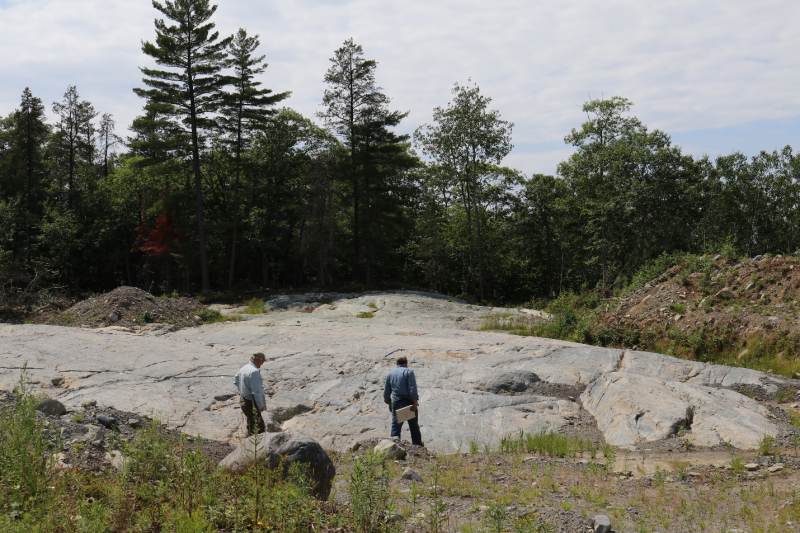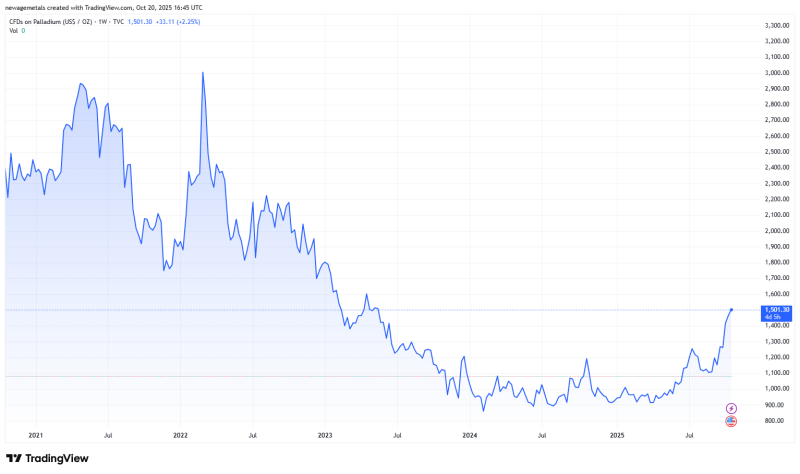Archive
New Age Metals Prepares its Platinum Group Metals Division to Launch
 | |||||||||
 |  |  |  | ||||||
October 23, 2025 – TheNewswire - Rockport, ON - New Age Metals Inc. (TSX.V: NAM; OTCQB: NMTLF; FSE: P7J.F) (“NAM” or the “Company”) is pleased to provide a corporate overview of its Platinum Group Metals (“PGM”) division, including updates on the flagship River Valley Palladium Project in Ontario and the Genesis PGM-Cu-Ni Project in Alaska, and commentary on the PGM market outlook. The PGM division forms a core part of NAM’s strategy to develop critical and precious metal projects in North America.
Highlights of the PGM Division
-
The River Valley Palladium Project is 100% owned by New Age Metals. The Project is currently at the development stage, having completed a Preliminary Economic Assessment (“PEA”) in 2023. River Valley is a multi-million ounce Palladium-dominated Mineral Resource. The current Mineral Resource Estimate contains 2.3 Moz of palladium + platinum + gold in the Measured and Indicated classification (plus 1.6 Moz Inferred) at a $15/tonne NSR cut-off. In addition, copper could be a significant potential byproduct of eventual Palladium and Platinum mining
-
The Alaskan Genesis PGM-Cu-Ni Project is also 100% owned by New Age Metals. The Project is road-accessible, has powerline access and is strategically located ~65 km south of Glennallen and ~265 km east of Anchorage. Surface exploration has identified reef-style PGM mineralization (chromite-hosted, with grab samples up to 2.4 g/t Pd and 2.4 g/t Pt) and magmatic Ni-Cu sulfides (samples up to 0.96% Ni and 0.58% Cu) across multiple zones. NAM completed an exploration summer 2025 field program and is in the process of organizing a phase 2 follow up program.
-
Palladium reached an all-time-high price in 2022 of ~US$3,400 per ounce. We are once again seeing a resurgence in the prices of both Palladium and Platinum as prices of Gold and Silver are trading at all time highs. It is important to note that Palladium and Platinum are also precious metals. Palladium is trading +65% YTD and Platinum is trading +70% YTD.
1 Company press release titled “New Age Metals Delivers New Positive Preliminary Economic Assessment of the River Valley Project”, dated June 29, 2023.
River Valley Palladium Project Overview
The River Valley Palladium Project is NAM’s flagship asset, located approximately 100 km east-northeast of the City of Sudbury, Ontario. The deposit is a large, near-surface disseminated PGM-copper sulphide system hosted in the Paleoproterozoic-age River Valley Intrusion.
It currently ranks as one of Canada’s largest undeveloped primary PGM deposits, with an
NI 43-101 compliant Mineral Resource of approximately 2.3 million ounces of combined palladium, platinum and gold in the Measured and Indicated classifications, plus 1.6 million ounces in the Inferred classification.
Figure 1: River Valley Project
Harry Barr, NAM’s Chairman & CEO, noted that “As opposed to the 2019 PEA, which design was based on a series of open pit along the strike length of the River Valley Project and it was geared towards a large, bulk tonnage open pit scenario, the 2023 PEA outlines a smaller, higher-grade operation with lower CAPEX, expanded underground mining, and a much smaller environmental footprint. Except for a hydrometallurgical PGM recovery test study, River Valley has been inactive since 2024, when Palladium prices fell below US$1,000/oz Pd. With the resurgence in PGM prices in 2025, NAM is making plans to relaunch the River Valley Project.”
Beyond the PEA, NAM continues to de-risk and add value to River Valley. Comprehensive environmental baseline studies, re-initiated in 2020 after a long hiatus, were ongoing through 2024 to build a stronger foundation for future permitting. These studies cover surface water and groundwater monitoring, hydrology, flora/fauna surveys, and more, and have actively involved local Indigenous communities in the field data collection process. This proactive approach to environmental and community engagement at this early stage is expected to position River Valley favorably for advanced development milestones. The Company has a current Memorandum of Understanding (“MOU”), with which we strive to build and maintain a strong working relationship with the Nipissing First Nation and the Temagami First Nation, who have traditional claims to the land.
In late-2023, NAM commissioned Platsol™ testwork with SGS Canada Ltd. to evaluate recovery of PGMs via hydrometallurgy (which could potentially produce refined metals on-site), aiming to boost platinum and rhodium recoveries and improve project economics. The positive results from these studies will be a guide to the next phase of project engineering2.
NAM is also planning a series of additional drilling programs to convert Inferred to Indicated Mineral Resources and exploring down-dip/down-plunge extensions of the known mineralized zones, with the goal of expanding the Mineral Resource base and increasing the proportion of higher-grade material in future mine plans.
The Project has several high priority drill targets, particularly at depth. With a significant exploration budget, the Company has the possibility of expanding its Mineral Resources on the River Valley Project. Together, these initiatives are advancing River Valley toward the Pre-Feasibility Study and Feasibility Study stages and, ultimately, a production decision.
Additionally, the Company has submitted to the Ontario Ministry of Energy and Mines and our First Nation Partners, new three-year exploration permit applications. The permits are expected to be in place by year end and will allow the Company to carry out work on the River Valley Project, which is to the north (as defined in the 2023 PEA), and the Mustang Zone, along strike to the south, for the first time since the previous operators drilled approximately 67 holes (~16,440 metres) in the early 2000s. The collective length of the known River Valley mineralized zones (10) is approximately 16 km (10 miles).
2 Company press release titled ”NAM Reports High PGM Recoveries from Proof-of-Concept Platsol Testwork on River Valley”, dated February 29, 2024.
Genesis PGM-Cu-Ni Project Overview
The Genesis PGM-Cu-Ni Project is an earlier-stage exploration project located in the Valdez Creek mining district of southern Alaska, approximately 265 km east of Anchorage. NAM owns 100% of Genesis, which encompasses 4,144 hectares (10,240 acres) of State of Alaska mining claims in a geologically prospective mafic/ultramafic complex. A key advantage of Genesis is its exceptional access and infrastructure for a remote Alaskan project. The claim block lies within 3 km of the all-season Richardson Highway and a high-capacity electric transmission line, with historical access trails reaching into the property from a nearby lodge on the highway. This proximity to infrastructure substantially lowers the logistical barriers for exploration and future development compared to typical greenfield projects in Alaska. Recently, the Trump Administration has made several key investments in both Canadian and US companies that are developing rare earth and critical metal projects in America. The week of October 13th, the Canadian Federal Government announced plans to similarly fund Canadian critical metal projects as well as JP Morgan Chase announced a plan to invest up to $10 billion in U.S. companies critical to national security and economic resilience as part of a broader $1.5 trillion pledge.

Figure 2: Map showing a portion of the ATV trail (red line), walking trail (green line) and the preliminary sample points (yellow dots) from the fieldwork portion of the project.
Surface exploration to date has identified two compelling styles of magmatic mineralization at Genesis. The first is a reef-style PGM mineralization hosted by chromitite layers, analogous to the Platreef or Bushveld-type occurrences – selective rock sampling has returned grades of up to 2.4 g/t Palladium and 2.4 g/t Platinum in these chromite-hosted PGM reefs. The second style is disseminated to massive nickel-copper sulfide mineralization, with surface samples assaying up to 0.96% Ni and 0.58% Cu, along with associated PGMs. Notably, these mineralized zones occur at surface and have been traced in outcrop for roughly 2,000 metres of strike length with approximately 40 m true thickness in one target area (Sheep Hill). Both the PGM-bearing reefs and the Ni-Cu sulfide zones remain open in all directions (west, east, north, and at depth), indicating significant room to expand known mineralization with further exploration drilling.
The broader exploration potential at Genesis is underscored by the scale of the geochemical and geophysical anomalies on the property. PGM and base metal anomalies have been identified along a 9 km trend across the prospect, and multiple target areas remain untested by any drilling. In the summer of 2025, NAM completed a field program focused on detailed geological mapping and sampling at Sheep Hill, collecting 134 new rock samples (163 including QA/QC blanks/standards) which have been sent for assay, with results pending. This work further refined the target zones and improved trail access ahead of an eventual maiden drill program. Genesis represents a promising discovery-stage PGM project in a mining-friendly jurisdiction, and NAM’s strategy is to leverage partnerships to unlock its value. The Company is actively seeking an earn-in or joint venture partner to advance Genesis, given the project’s large scale and the significant exploration capital required to fully assess its potential. A partnership would allow NAM to remain focused on its flagship River Valley Project while still benefiting from major exploration successes at Genesis through retained ownership.
About Platinum Group Metals (PGMs) and Market Outlook
Platinum Group Metals (PGMs) – primarily palladium, platinum, and rhodium – are critical metals for modern industry and clean technology. Their unique properties include catalytic activity, high melting points, and resistance to corrosion, which enable a wide range of applications. The automotive sector is the largest consumer of PGMs: over 80% of annual palladium and rhodium output is used in catalytic converters to reduce vehicle emissions, helping cars meet stringent air quality standards. Platinum is also used in catalytic converters (especially for diesel engines) and is increasingly important in next-generation hydrogen fuel cells for vehicles and energy storage, where it serves as a critical catalyst. In addition, hybrid cars may use as much as three times the PGM loading compared to traditional cars. Beyond automobiles, PGMs are used in jewelry (platinum and palladium provide durable, tarnish-resistant settings), electronics (small amounts of PGMs in circuit boards, hard disks, and sensors improve performance), medical devices and pharmaceuticals (e.g. platinum in pacemakers and anti-cancer drugs), as well as chemical and petroleum refining (platinum/palladium catalysts for production of chemicals and fuel). This diversity of uses underpins a robust baseline demand for PGMs across economic cycles.
More recently, analyst started discussing the increased use of platinum and palladium as a store of value, like gold, due to the fact it has a higher density and is easier to transport compared to silver.
The market outlook for PGMs remains positive, driven by constrained supply and evolving demand in both traditional and emerging applications. Global PGM supply is highly concentrated geographically, which poses supply risks. South Africa alone produces about 70 to 80% of the world’s platinum (and most of the rhodium, iridium, and ruthenium), whereas Russia is the top palladium supplier (around 40% of global output). In recent years, PGM markets have been in deficit as demand outstripped supply. Notably, the platinum market entered a structural deficit in 2021–2022 and is forecast to remain in deficit through 2025, according to Johnson Matthey’s latest analysis. Palladium had over a decade of consecutive deficits (2012–2024), which drove prices to the record highs., In 2025, palladium is expected to move closer to balance as automotive demand eases slightly and recycling increases.
Figure 3: 5-year price chart for the price of palladium per ounce in US Dollars.
Palladium is up 68.4%.
Tighter emissions regulations in Europe, China, and other regions are maintaining high loadings of PGMs in exhaust after-treatment systems. Looking ahead, emerging growth areas such as the coming hydrogen economy are expected to bolster PGM demand – platinum-based catalysts are essential for proton-exchange membrane (“PEM”) fuel cells and for electrolysers that produce hydrogen fuel. Coupled with limited new mine supply and the concentration of existing supply in a few jurisdictions, the fundamentals for PGMs can be said to be a favorable market outlook in the medium and long term. In Canada and the US, PGMs are classified as Critical Minerals due to their irreplaceable role in reducing emissions and enabling technologies like fuel cells and the dominance of supply from high-risk international sources.
Unprecedented Government Support for Critical Metals
Recently Analysts have stated that this level of investment in mining projects from both countries was only available during short periods in World War I and II. Finally, the mining industry’s corporates Management teams have additional methods of mine finance and believe their industry is entering into unprecedented territory for critical metals exploration and mine developments.
About NAM
New Age Metals is a junior mineral exploration and development company focused on the discovery, exploration, and development of critical green and precious metal projects in North America. The Company has four divisions: a Platinum Group Element division, Gold Division, a Lithium/Rare Element division, an Antimony-Gold Division as well as an investment in MetalQuest Mining’s (TSXV:MQM | OTC:MQMIF) a high purity Lac Otelnuk Iron “Ore” Project.
The PGE Division includes the 100% owned, multi-million-ounce, district-scale River Valley Project, one of North America’s largest undeveloped Platinum Group Element Projects, situated 100 km by road east of Sudbury, Ontario. In addition to River Valley, NAM owns 100% of the Genesis PGE-Cu-Ni Project in Alaska. The PGM Division is both an industrial and critical metal division.
On October 1st 2025, the Company announced that it has entered into agreement to option the Bonanza Gold Project, located in the Kenora Gold District. The Project consists of 114 mining claims and 1 patented Mining Claim totalling 2,191 hectares or 5,414 acres. The Project has multiple high-grade mineral occurrences with spectacular visible gold at surface along with excellent infrastructure including road access to all areas of the Project along with provincial grid power lines. The Kenora Gold District is known for its high-grade Archean lode-gold deposits and has supported mineral exploration and some mining- for more than a century. Some of the active majors and mid-tier companies in the District are Agnico Eagle, Kinross, Centerra and New Gold. NAM’s technical team is currently working on the exploration plan and budget for the balance of 2025 and for 2026. Further announcements on the Bonanza Gold Project will be forth coming.
The Company’s Lithium Division is one of the largest mineral claim holders in the Winnipeg River Pegmatite Field, where the Company is exploring hard rock lithium and various rare elements such as tantalum, rubidium, and cesium. NAM is developing its lithium division in conjunction with its Farm-in/Joint Venture agreement with Mineral Resources Ltd. (“MinRes”), one of the world’s largest lithium producers. A minimum budget to maintain the Projects has been approved by Mineral Resources Ltd for May 2025 to April 2026. The Companies agreed to the minimum budget due to current lithium pricing and forest fire dangers in the immediate area
In April 2024, a $1.5M NSERC Alliance grant was awarded to a collaboration led by the University of Manitoba (Drs. Fayek and Camacho), with academic partners from Lakehead University (Dr. Hollings) and industry partners including New Age Metals and Grid Metals. This research is focused on advancing Canada’s critical metals sector, with New Age Metals’ portion targeting its Bird River lithium properties. Approximately $107,000 of work is planned on New Age’s properties in 2025. The early work will include core sampling and field visits starting this summer. The project will likely extend beyond the original 3-year term, due to its delayed start.
New Age Metals Inc. is supporting a successful $180K Mitacs research grant, awarded in 2023, through its $90K contribution (already accounted for and paid under the Mineral Resources joint venture). This academic partnership with the University of New Brunswick and the University of British Columbia is focused on understanding the origin and controls of lithium pegmatite mineralization in the Cat Lake–Winnipeg River field. Fieldwork for the MSc. thesis has been completed, while the post-doctoral phase is ongoing at UNB. This collaboration provides access to top-tier scientific expertise and equipment, significantly reducing analysis costs and adding long-term value to the project.
NAM’s Gold-Antimony division is in Newfoundland and spans roughly 20,000 hectares. The majority of these properties are in St. Alban’s area, along Canstar’s Swanger and Little River mineralized trends. The remaining properties are strategically located along the same geological trend as the past-producing Beaver Brook Antimony Mine and in proximity to New Found Gold’s Queensway South Gold Project. Management has recently completed Phase 1 Exploration of the Project, Phase 2 has been initiated, and further news will follow. On July 30th, the Company was pleased to announce that it has received formal approval under Newfoundland and Labrador’s Junior Exploration Assistance (“JEA”) Program, including eligibility for the Critical Minerals Assistance (“CMA”) and Provincial Critical Mineral Assistance (“PCMA”) streams. The potential rebate total for eligible exploration activities is $71,975.
On August 6, 2025, New Age Metals announced an additional investment in a 4th critical metal. NAM currently owns approximately 12.79% and holds warrants that, if exercised with today’s issued and outstanding shares of MQM, would bring NAM to a 19.05% interest in MetalQuest Mining inc.
MetalQuest Mining inc. is developing one of North Americas largest iron “ore”3 projects at Lac Otelnuk (Québec), where approximately $120 million has been spent on the project. For more information, please visit MetalQuestMining.com. High-purity iron oxide became a critical metal Federally in Canada and in the Provinces of Quebec and Newfoundland and Labrador in 2024. In the summer of 2025, MQM contracted AtkinsRealis, an international engineering company, to complete a GAP Analysis on the Lac Otelnuk Project and its 2015 Feasibility Study.
Management is currently aggressively seeking new mineral acquisition opportunities on an international scale. Our philosophy is to be a project generator with the objective of expending sufficient explorations and development expenditure to eventually option our projects with Major and Junior mining companies through to exploration and development phases on to production.
The Company is actively seeking an option/joint venture partner for our and its road-accessible Genesis PGE-Cu-Ni Project in Alaska.
Investors are invited to visit the New Age Metals website at www.newagemetals.com where they can review the company and its corporate activities. Any questions or comments can be directed to info@newagemetals.com or Chairman and CEO Harry Barr at Hbarr@newagemetals.com or Vice President, Investor Relations Farid Mammadov at Faridm@newagemetals.com or call 613 659 2773.
3 Cautionary Note: No current National Instrument 43-101 Mineral Reserve Estimates exist for the Lac Otelnuk Project.
The contents contained herein that relate to Exploration Results, Mineral Resources and the PEA for the River Valley Project and for the Mustang Zone is based on information compiled, reviewed or prepared by Dr. Bill Stone, P.Geo., Lead Geoscience Consultant for New Age Metals. Dr. Stone is the Qualified Person as defined by National Instrument 43-101 and has reviewed and approved the geoscience-related technical content of this news release.
Robert M Retherford, CPG #10904, is a Qualified Person for the purposes of National Instrument 43-101 Standards of Disclosure for Mineral Projects and a consultant to NAM, has reviewed and approved the scientific and technical disclosure in this press release relating to the Genesis Project. The Qualified Person has not completed sufficient work to verify the historical information on the project.
If you have not done so already, we encourage you to sign up on our website (www.newagemetals.com) to receive our updated news.
On behalf of the Board of Directors
“Harry Barr”
Harry G. Barr
Chairman and CEO
Neither the TSX Venture Exchange nor its Regulation Services Provider (as that term is defined in the policies of the TSX Venture Exchange) accepts responsibility for the adequacy or accuracy of this release. Cautionary Note Regarding Forward Looking Statements: This release contains forward-looking statements that involve risks and uncertainties. These statements may differ materially from actual future events or results and are based on current expectations or beliefs. For this purpose, statements of historical fact may be deemed to be forward-looking statements. In addition, forward-looking statements include statements in which the Company uses words such as “continue”, “efforts”, “expect”, “believe”, “anticipate”, “confident”, “intend”, “strategy”, “plan”, “will”, “estimate”, “project”, “goal”, “target”, “prospects”, “optimistic” or similar expressions. These statements by their nature involve risks and uncertainties, and actual results may differ materially depending on a variety of important factors, including, among others, the Company’s ability and continuation of efforts to timely and completely make available adequate current public information, additional or different regulatory and legal requirements and restrictions that may be imposed, and other factors as may be discussed in the documents filed by the Company on SEDAR+ (www.sedarplus.ca), including the most recent reports that identify important risk factors that could cause actual results to differ from those contained in the forward-looking statements. The Company does not undertake any obligation to review or confirm analysts’ expectations or estimates or to release publicly any revisions to any forward-looking statements to reflect events or circumstances after the date hereof or to reflect the occurrence of unanticipated events. Investors should not place undue reliance on forward-looking statements.

